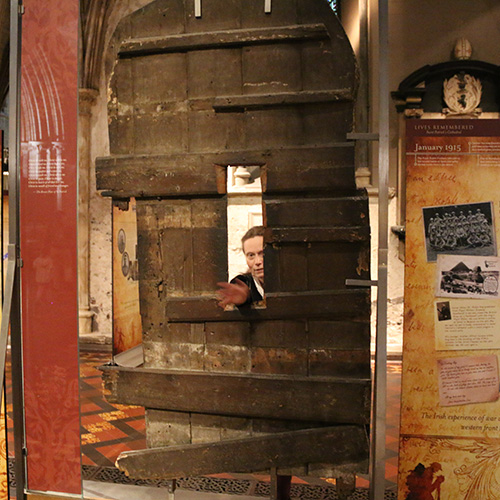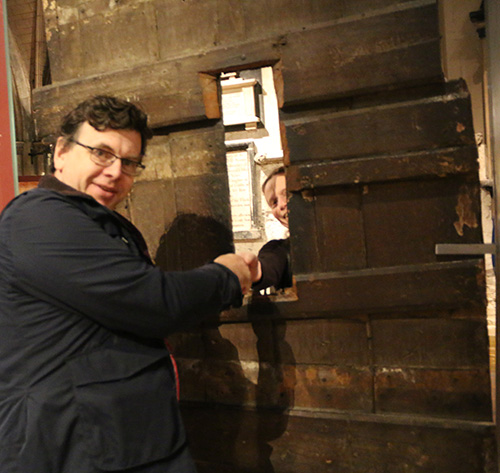In the summer of 2017 we spent our holidays in Ireland and staying near Dublin. One day we headed up into the Wicklow hills and visited Glendalough. The name Glendalough comes from the Irish Gleann Dá Loch which means “Valley of two lakes.” It is a “does what it says on the tin” type of name as it is a glacial valley with an upper and lower lake. It is area of great natural beauty and at least before the pilgrims and later the tourists came would have been a very peaceful spot. Small wonder then that it is the site of an Early Medieval monastic settlement which was founded in the 6th century by St Kevin.
The life of St Kevin is not well documented and in fact no records survive from his life time or even close to it. So as with many cases in this period we have to turn to the often unreliable saint’s life accounts. In the case of St Kevin there is a late medieval Latin Vita found in the records of the Franciscan Convent in Dublin. According to this account, Kevin’s name was Coemgen (anglicized to Kevin. He was of noble birth. He was the son of Coemlog of Leinster and was born (according to the tales) in 498 at the Fort of the White Fountain. The account also goes on to relate miracles and other events. One example was the legend that a white cow visited every morning and evening and supplied the milk for the baby.

The upper lake at Glendalough and the site of St Kevin’s bed.
In time Kevin was ordained and according to the Vita was led by an angel to the remote location of the upper lake at Glendalough where he lived as a hermit in a cave (the cave is actually a former Bronze Age tomb which after Kevin’s time was known as St. Kevin’s Bed). Here, so the tales go, Kevin’s companions were the animals and birds. For seven years he live alone, sleeping on stones, wearing skins and eating little and praying.
In time he began to attract followers who built the first monastery on the shores of the upper lake. Having established a thriving community, Kevin retired into solitude again in 544 but was persuaded to rejoin his followers by 550. The tales then say he presided over the monastery until his death in 618 at the extreme age of 120! Today Kevin is one of the patron saints of the diocese of Dublin.
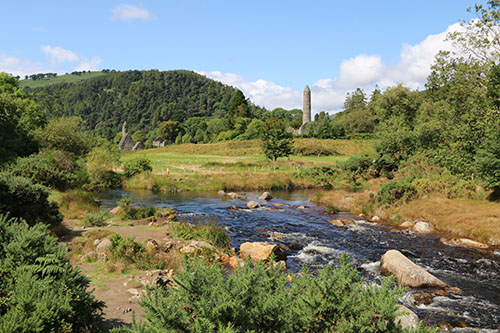
The monastery as seen from the visitor centre.
In the centuries after Kevin’s death, Glendalough became one of the main pilgrimage attractions of medieval Ireland. It was said that to be buried in Glendalough was as good as being buried in Rome. It was also the case that several trips there equated to the much longer pilgrimage to Rome. Thus many Kings and Queens and bishops were buried here.
The golden age at Glendalough was between 1000 and 1150AD during the reigns of the Irish kings Muirchertach Ua Briain (of Munster), Diarmait mac Murchada (of Leinster) and Toirdelbach Ua Conchobair (of Connacht). The most famous abbot of Glendalough Lorcán Ua Tuathail (Laurence O’Toole) went on to be the first archbishop of Dublin. He died in 1180. These kings and bishops and others were involved in constructing the stone buildings that survive to the present day and which are there for the visitor to enjoy. The site of the medieval period monastery was near the lower lake.
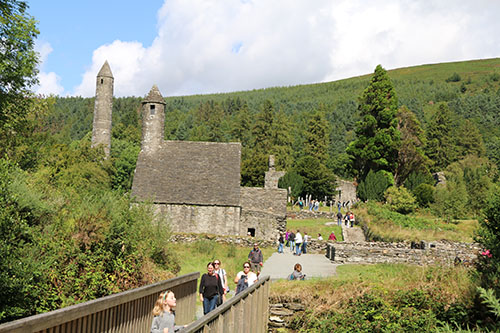
Today there is a visitor’s centre at the site which includes a small museum and videos of the history of the monastery. From the visitors centre it is a 5 minute walk over fairly easy ground to the site.
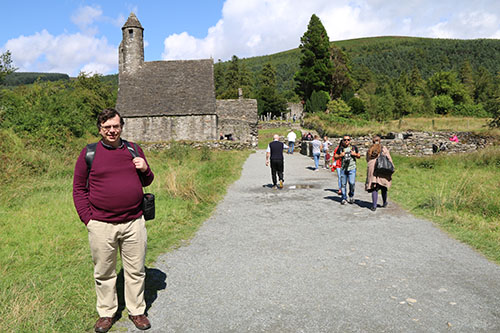
We were lucky that after a day or two of rain the sun came out for our visit. Here you can see me posing with St Kevin’s chapel in the background.
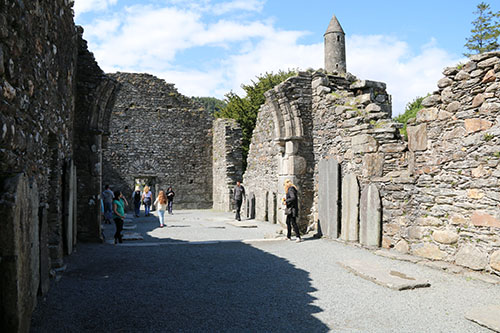
Inside the cathedral looking west.
The largest building at Glendalough is the cathedral. The earliest parts of this actually come from an earlier church – the stones being reused in the west doorway seen above.
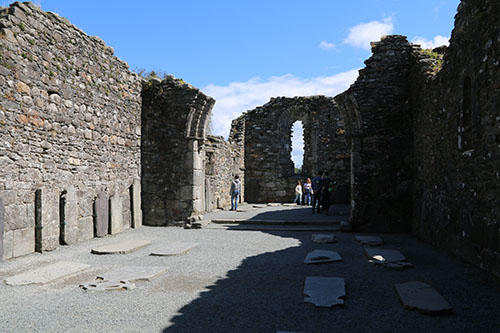
Inside the cathedral looking east
The chancel and sacristy are later and date from the late 12th and early 13th centuries. The chancel arch can be seen above with the east window beyond.
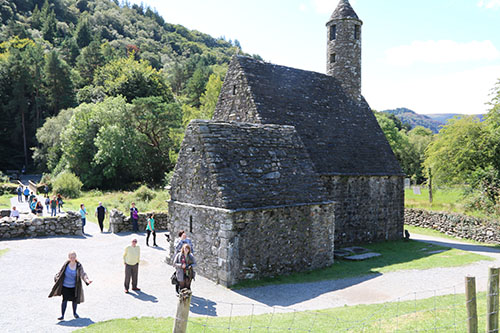
There are other smaller churches on the site including St Kevin’s chapel (above). The church also has a belfry with a conical cap and four small windows at the west end of the roof that looks rather like a miniature round tower.
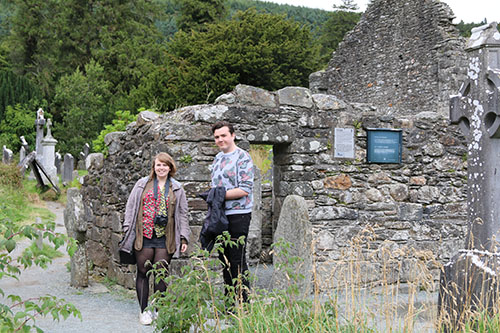
Apart from the churches and cathedral, the site has evidence of a number of buildings including a reconstructed ‘Priests’ House.’ It is not known what the original purpose of the building was – possibly housing relics. It gets its modern name from the practice of interring priests there in the 18th and 19th centuries.
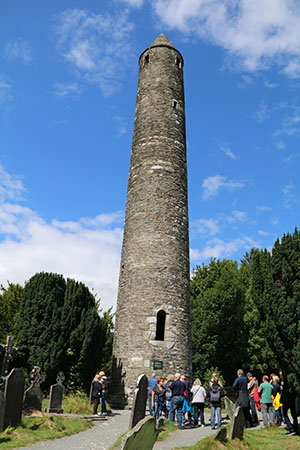
To me the jewel in the crown was the round tower at Glendalough. It is considered to be one of the most finely constructed and beautiful towers in Ireland. The tower is over 30m high (just under 100 feet). The body of the tower is original although the roof was rebuilt in 1876 using original stones. The tower has 6 timber floors, connected by ladders. The four storeys above the entrance feature a small window with the top having four windows. The door is about 3.5 meters or 10 feet from the ground. It is clearly designed for defence. Refuge seekers could retire inside then raise the ladder making it very hard to attack. The tower was built in the years after centuries of Viking raids so this was an sensible decision and wise precaution.
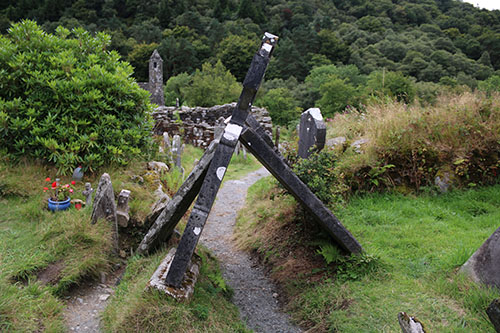
The site is now dotted with gravestones of varying age – many (as above) in a state of disrepair. One caught my eye. You may recall that St Kevin was supposed to have lived until the age of 120. That might seem far fetched and yet I found this below engraving recording the death in 1950 of a Walter Byrne aged 106! Maybe there is something in the air or water here.
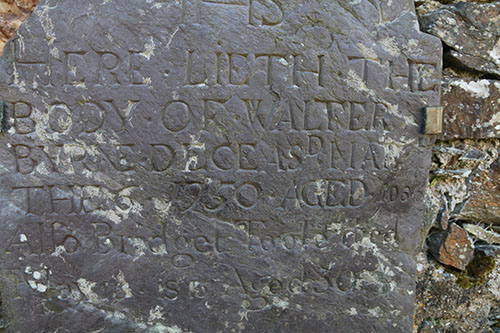
Glendalough was for centuries a centre of learning. The monks and scholars produced many manuscripts in Irish and Latin, including astronomical and mathematical texts and chronicles. One of the most famous manuscripts is the 12th century book of Glendalough which is now preserved in the Bodleian library in Oxford.
In 1214, the dioceses of Glendalough and Dublin were united which led to a decline in the cultural and ecclesiastical status of Glendalough. Finally in 1398 the valley was attacked by English forces and settlement destroyed which left the site a ruin although still seen as a place of pilgrimage.
For more details on the Glendalough Visitor Centre click here.


